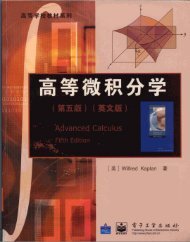Milne - Group Theory.. - Free
Milne - Group Theory.. - Free
Milne - Group Theory.. - Free
Create successful ePaper yourself
Turn your PDF publications into a flip-book with our unique Google optimized e-Paper software.
26 3 ISOMORPHISM THEOREMS. EXTENSIONS.<br />
Remark 3.10. It will be useful to have a description of (Z/nZ) × =Aut(C n ). If<br />
n = p r 1<br />
1 ···prs s is the factorization of n into powers of distinct primes, then the Chinese<br />
Remainder Theorem (Dummit and Foote 1991, 7.6, Theorem 17) gives us an<br />
isomorphism<br />
Z/nZ ∼ = Z/p r 1<br />
1 Z ×···×Z/p rs<br />
s Z, m mod n ↦→ (m mod p r 1<br />
1 ,...,m mod p rs<br />
s ),<br />
which induces an isomorphism<br />
(Z/nZ) × ≈ (Z/p r 1<br />
1 Z) × ×···×(Z/p rs<br />
s Z)× .<br />
Hence we need only consider the case n = p r , p prime.<br />
Suppose first that p is odd. The set {0, 1,...,p r − 1} is a complete set of representatives<br />
for Z/p r Z,and 1 of these elements are divisible by p. Hence p (Z/pr Z) × has<br />
order p r − pr<br />
= p<br />
pr−1 (p − 1). Because p − 1andp r are relatively prime, we know from<br />
(1.3d) that (Z/p r Z) × is isomorphic to the direct product of a group A of order p − 1<br />
and a group B of order p r−1 .Themap<br />
(Z/p r Z) × ↠ (Z/pZ) × = F × p ,<br />
induces an isomorphism A → F × p ,andF× p , being a finite subgroup of the multiplicative<br />
group of a field, is cyclic (FT, Exercise 3). Thus (Z/p r Z) × ⊃ A = 〈ζ〉 for some element<br />
ζ of order p − 1. Using the binomial theorem, one finds that 1 + p has order p r−1<br />
in (Z/p r Z) × , and therefore generates B. Th us (Z/p r Z) × is cyclic, withgenerator<br />
ζ · (1 + p), and every element can be written uniquely in the form<br />
On the other hand,<br />
ζ i · (1 + p) j , 0 ≤ i

















